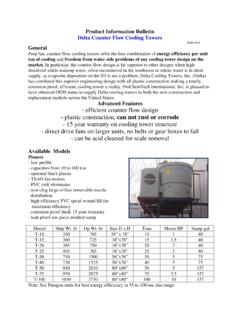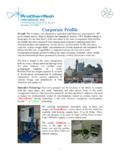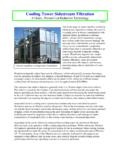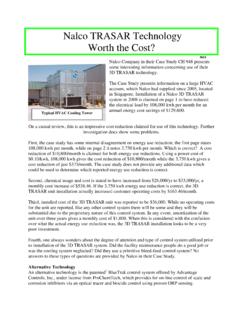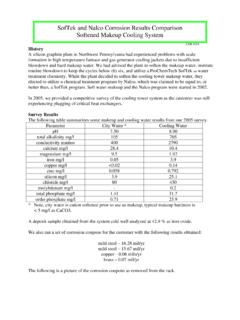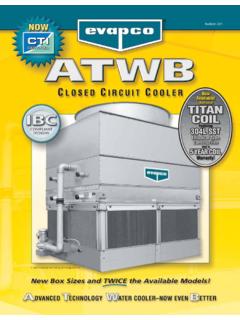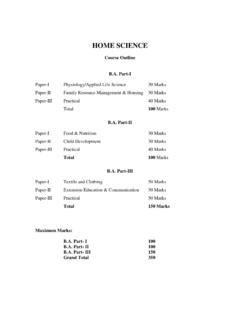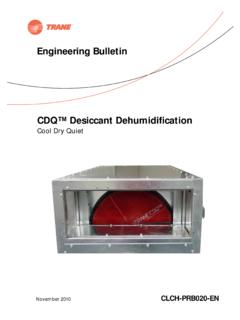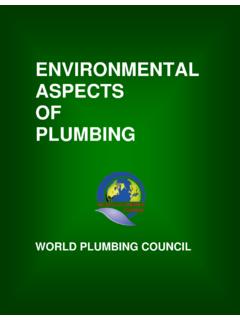Transcription of Basic Cooling Water Management II - ProChemTech
1 Cooling Water Management Basic Principles and Technology By: Timothy Keister, CWT. Fellow, American Institute of Chemists Certified Water Technologist, Certificate #90. ProChemTech International, Inc. Apache Junction, AZ, and Brockway, Pennsylvania Distribution: General Issue: 08/30/01. Last revision: 03/08. I. INTRODUCTION. Evaporative Cooling towers are very popular as they provide the most cost effective Cooling technology for commercial air conditioning and industrial processes. However, drought conditions and increasing Water usage have combined to decrease the availability and increase the cost of the good quality, low hardness Water preferred for Cooling tower makeup use.
2 At the same time, stricter environmental restrictions on effluent discharge have resulted in increased fees for disposal of Cooling tower blowdown to the sewers. The addition of these concerns to the existing requirements for control of scale, corrosion, deposition, and biological fouling has increased the difficulty and costs associated with operating a Cooling tower Water system. In spite of these concerns, treatment and control of Cooling tower Water is commonly neglected, which is then responsible for substantial problems due to downtime, equipment damage, loss of process control, Water is not missed high Water use, environmental violations, safety hazards, till the well runs dry.
3 And increased energy usage. Neglect of Cooling Water Benjamin Franklinspqr results from two major facts: first, the user often does not appreciate that Cooling Water is a vital part of the facility operation or production process; and second, that misinformation, fraudulent products, and marketing hype are common when Cooling Water treatment is the issue under discussion due to the proprietary nature of the Water Management business. This paper is intended to provide the Cooling Water user with a Basic knowledge of Cooling Water Management so that problems resulting from corrosion, scale, deposition, and biological fouling can be avoided.
4 Reduction of operating costs from increased efficiency in use of energy and control of both makeup Water and sewerage use will be discussed as well as health and safety hazards, environmental problems, zero blowdown operation, USGBC LEED certification, supplier selection, and non-chemical devices. Except where specific proprietary processes are unique or patent protected, we will utilize generic descriptions. Expressed opinions are based on active participation in the Cooling Water Management field since 1973. Evaporative Cooling Tower A Cooling tower is simply a device for rejection of unwanted heat into the atmosphere. The fact that Water is a low cost, convenient, and highly effective heat transfer medium, and that evaporation of a pound of Water requires about 1000 btu, makes the evaporative Cooling tower the most effective means for this heat transfer.
5 Water evaporation within the Cooling tower accounts for the majority of the heat rejected, typically 75 to 80% of the heat is removed from the Cooling Water by evaporation (E). The rest of the heat is removed by transfer to the substantial air flow passing through the Cooling tower. Page 2. For example, a 1000 ton rated Cooling tower is designed to have a heat rejection of 12 million btu/hr, 12,000 btu/hr/ton. At 80% heat rejection by evaporation, this unit will evaporate gpd/ton, or 26,550 gpd. Evaporation of Water in the Cooling tower concentrates the dissolved salts found in almost all Water sources, which increases the potential for scale, corrosion, and biological fouling.
6 In addition to the concentration of salts from evaporation, a 1000 ton unit operates at a design air flow rate of 271,000 cfm through the unit. Since a Cooling tower is also a very effective "air scrubber, passage of such large amounts of air through the device results in the addition of significant amounts of airborne dust and debris to the Cooling Water . Blowdown (BD), or intentional removal of Water from the Cooling tower, is required to prevent over concentration of salts and insoluble airborne debris and results in potential environmental problems, increased Water use, and wastewater disposal costs. The number of times that the replacement Water , makeup, (MU) is increased in concentration is commonly referred to as cycles (C), which is calculated by dividing the dissolved solids level (commonly measured as conductivity) in the Cooling Water by that of the makeup Water .
7 While generally not important unless a Cooling tower is to be operated at zero blowdown, windage (W) is a small loss of Cooling Water into the air stream passing through a Cooling tower. Windage is a direct function of the design of the Cooling tower and Water recirculation rate (R) through the unit. Typically, windage will be between and of the Cooling Water recirculation rate. In many areas of the country scale formation due to poor makeup Water quality prevents any cycling, while other areas are severely limited as to the maximum obtainable. Chemical treatment of the Cooling Water is thus required in many areas to permit cycling operation, to reduce Water usage, of an evaporative Cooling tower without formation of scale.
8 Typical Cooling Tower Installation for Air Conditioning Page 3. Scale, in addition to causing physical blockage of piping, equipment, and the Cooling tower, also increases the energy use of the chillers used in comfort Cooling . For example, the thermal conductivity of copper is 2674 btu/[hr(ft2)(F/in)], while the common Cooling Water scale calcium carbonate has a thermal conductivity of just btu/[hr(ft2)(F/in)]. The energy cost penalty for even a small amount of scale can be significant. For example, a calcium carbonate scale of just mil thickness is estimated to decrease thermal efficiency by %, which on a 1000 ton chiller would increase annual power costs by about $72,000/yr at current power costs and typical HVAC service loads.
9 Described as the "universal solvent," Water corrodes all materials of construction at different rates. Steel, being the lowest cost construction material for Cooling systems, is very common and is readily corroded by most Cooling waters. Other materials, such as copper, brass, and galvanized steel, are also corroded, though at generally lower rates. To obtain a useful life from a Cooling system, corrosion inhibitors are generally used to control the corrosion rates to an acceptable level. The Cooling Water environment (warm with high dissolved solids and debris loading) is an excellent medium for growth of microorganisms that may cause many severe problems.
10 Not only is there an increased risk of Legionnaires' Disease, but biofilms also plug Water passages and piping, help to accelerate corrosion, and reduce heat exchanger efficiency. The affect of biofilms on the power cost of chiller operation is often not appreciated. Looking at the thermal conductivity of biofilm, typically btu/[hr(ft2)(F/in)], it is substantially less conductive that the common calcium carbonate scale. Therefore, while a system may be scale free, any biofilm present will still cause excessive energy use. To prevent these problems, toxic chemicals referred to as "biocides" are added to Cooling towers to control the growth of unwanted microorganisms in the Cooling Water .
